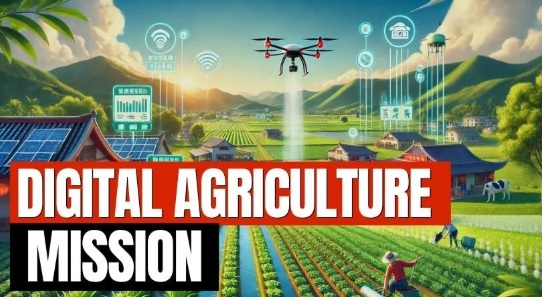
- Agriculture in India is undergoing a paradigm shift, driven by digitization, precision farming, remote sensing, and AI-based data analytics.
- To harness these advancements, the Government of India launched the Digital Agriculture Mission (DAM) 2021–2025, aiming to digitally empower Indian farmers and improve decision-making across the agricultural value chain.
What is Digital Agriculture?
- Digital agriculture refers to the use of digital technologies, such as:
- Precision farming
- Smart sensors
- Big data analytics
- Geospatial tools
- Web-based platforms
- Internet of Things (IoT)
- Artificial Intelligence (AI)
- These tools help monitor, optimize, and improve agricultural productivity and sustainability.
- Examples:
- Drones for Locust Control (used by the Indian government)
- GreenSense by Yuktix: A remote farm monitoring solution
- Fasal, DeHaat, and CropIn: Agri-tech startups using AI & IoT
Foundational Pillars of the Digital Agriculture Mission
The mission is built upon two major pillars:
- Agri Stack (Farmer Identity Platform)
- A farmer-centric Digital Public Infrastructure (DPI) designed to streamline service and scheme delivery using three key components:
- Farmer Registry: Creation of a unique Farmer ID as a digital identity for each farmer.
- Geo-referenced Village Maps: Linking Farmer IDs with land records, improving targeting of subsidies and schemes.
- Crop Sown Registry: Digital crop survey using satellite and on-ground data.
- Decision Support System (DSS) for Agriculture
- A comprehensive geospatial system integrating real-time data on:
- Crop health
- Weather patterns
- Soil moisture
- Water availability
- Developed using:
- RISAT-1A satellite data
- VEDAS (Visualization of Earth Observation Data and Archival System)
Key Features and Innovations
- Soil Profile Mapping: Detailed soil health monitoring at the plot level.
- Digital General Crop Estimation Survey (DGCES): Accurate crop yield forecasting.
- Data Integration: Linking digital tools with government portals like PM-KISAN, Soil Health Card, and Crop Insurance databases.
- Open APIs for private agri-tech start-ups to build scalable applications.
Targets and Goals
|
Goal
|
Timeline
|
|
Digital identity for 110 million farmers
|
Within 3 years
|
|
Nationwide digital crop survey
|
Within 2 years
|
|
Enhanced crop insurance and subsidy targeting
|
Ongoing
|
|
AI-enabled pest and disease forecasting
|
Ongoing
|
Benefits of the Mission
- Enhanced Decision-Making: Real-time, accurate information for farmers, policymakers, and researchers.
- Efficient Governance: Better targeting of subsidies and schemes.
- Market Linkages: Connecting farmers directly with buyers and processors through digital platforms.
- Climate Resilience: Monitoring weather and soil data to adapt cropping patterns.
- Transparency: Reduced corruption and leakages in agricultural support mechanisms.
Challenges Ahead
- Digital Literacy: Many farmers are not digitally literate or lack access to smartphones.
- Infrastructure Gaps: Poor internet connectivity in remote areas.
- Data Privacy: Concerns over use and storage of sensitive farmer data.
- Inter-departmental coordination: Seamless data integration between agriculture, land, weather, and satellite agencies is still evolving.
Way Forward
- Strengthening Agri-DPI (Digital Public Infrastructure) with privacy-first policies.
- Capacity Building of extension workers and farmers in using digital tools.
- Public-Private Partnerships to co-create and scale innovative solutions.
- Localized Solutions in regional languages tailored to specific agro-climatic zones.
- Integration with other missions like PM-Fasal Bima Yojana, Soil Health Mission, and Atmanirbhar Krishi.



